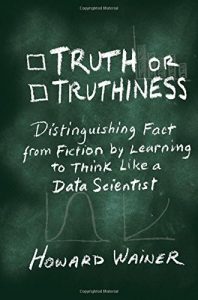I’ve torn through the late Hans Rosling’s Factfulness, completed by his son and daughter-in-law, Ola Rosling and Anna Rosling Ronnlund. I wish everybody could read it. The message in a nutshell is: learn to reflect about the news you read/hear, and appreciate that there’s a difference between good and better.
The book is written around a multiple choice quiz Rosling administered online and to many audiences he spoke to, which revealed that large majorities of all kinds of audiences (including Nobel prize winners and the Davos elite) get certain basic facts very badly wrong. In a lot of ways, things are not at all great, around the world. But they are a lot better than they used to be, and a lot better than most people think they are. This applies to health and longevity, girls’ education, violent crime, and so on.
In terms of applying a bit of thought to the drama of the news, Rosling gives very practical advice: always think about the size of number you hear – what is a good comparator, should it be a ratio; don’t always extrapolate in a straight line; don’t mistake the extremes for the typical experience; understand the power of exponential change. He means ‘factfulness’ as an analogue to ‘mindfulness’ (but much more worthwhile).
I like Rosling’s philsosophy: “The goal of higher income is not just bigger piles of money. The gola of longer lives is not just extra time. The ultimate goal is to have the freedom to do what we want.” I agree with his diagnosis that fear plays a big part in our responses to news: “Critical thinking is always difficult but it’s almost impossible when we’re scared.”
Although (to boast a bit) I got 12/13 on the quiz, I learned a lot from the book. For instance, I was struck by his argument that given we know 88% of the world’s children now get vaccinated, this tells us most countries can now sustain the logistics and infrastructure of the necessary cool chains; “This is exactly the same infrastructure needed to establish new factories,” Rosling writes. Yet 88% of the investors he quizzed thought only 20% of children get vaccinated so don’t know about that opportunity. He also argues that big pharma is missing a business opportunity in its focus on expensive new drugs for the richest markets, when they could offer older drugs at lower prices in the extensive middle income markets.
The book is also a delightful read, full of personal anecdote. One can hear his voice, which is a testament to the loving work his son and daughter-in-law put into preparing it for publication. Also worth a look is Anna Rosling Ronnund’s fascinating Dollar Street photography project.
[amazon_link asins=’1473637465′ template=’ProductAd’ store=’enlighteconom-21′ marketplace=’UK’ link_id=’094e97d8-3feb-11e8-8233-cba25c96d314′]

